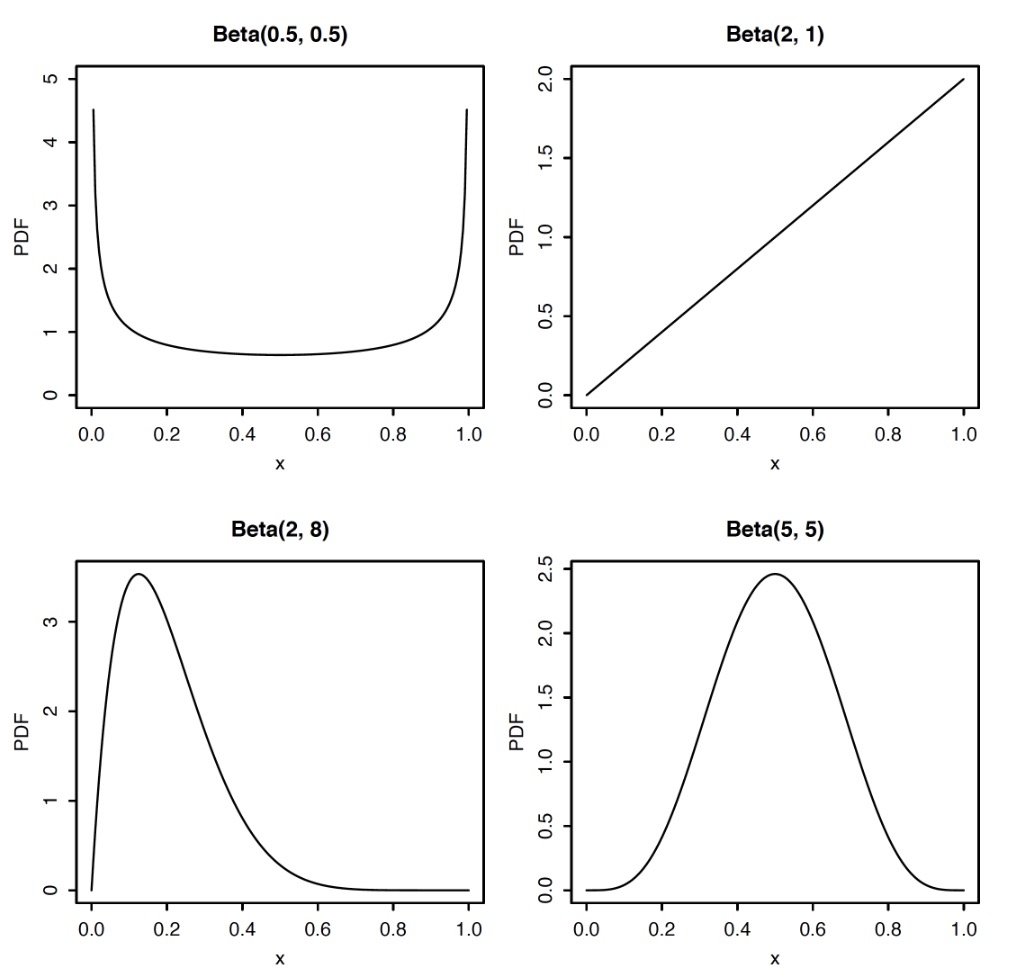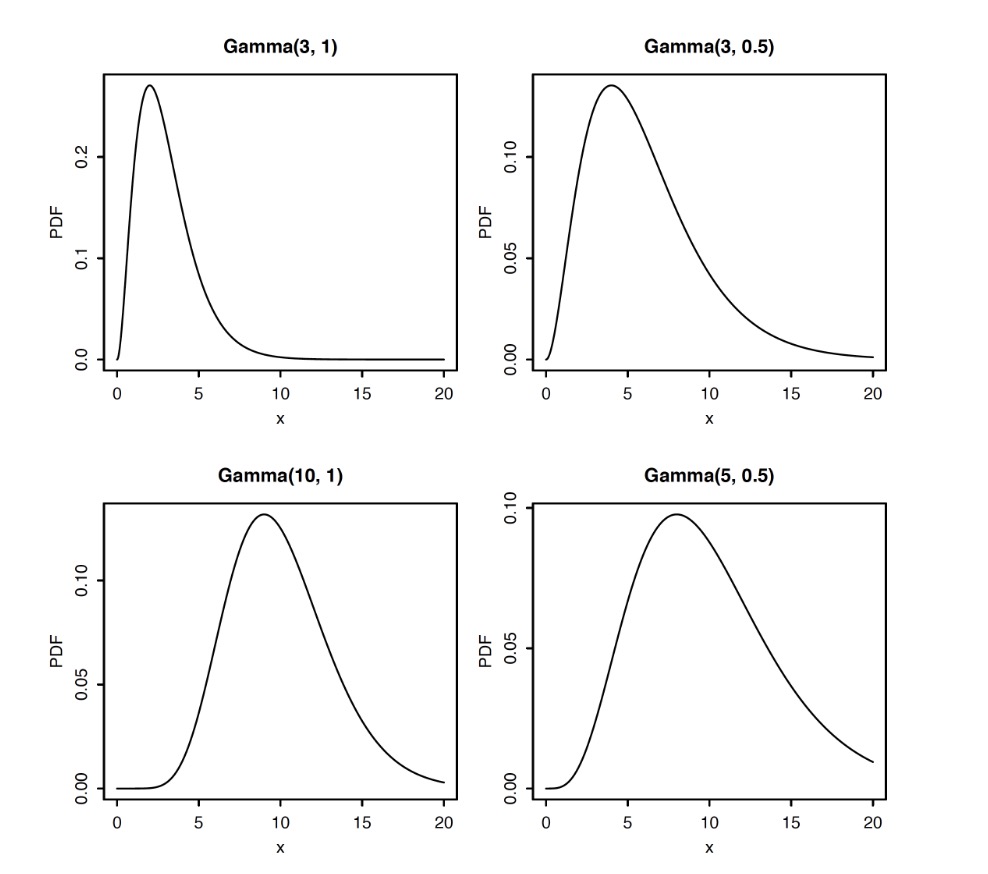Beta-Binomial Distribution
Definition (Beta Distribution)
An r.v. $X$ is said to have Beta distribution with parameters $a$ and $b$, if its PDF is
where $\beta(a,b)$ is constant to make PDF integrate to 1, We write this as $X\sim Beta(a,b)$
By varying the values of $a$ and $b$, we get PDFs with a variety of shapes
Beta Distribution is the generalization of uniform distribution while $a=b=1$
The Beta is a flexible family of continuous distributions on (0,1), and has many stories. One is Beta r.v. often used to represent an unknown probability. we can use Beta to put probabilities on unknown probabilities If a parameter $p$ satisfies $0<p<1$, we can assume the prior distribution of $p$ is Beta(a,b)
Beta Integral
One inportant issue to analyse the Beta Distribution is the Integral
Bayes’ billiards
It’s hard to get the reuslt directly from calculus, the left and right sides of the above formulation can be connected by one event $P(X=k)$
Left side Story : Having $n+1$ balls , $n$ white and $1$ gray. Randomly throw each ball onto the interval $[0,1]$, so the position of balls are i.i.d. $Unif(0,1)$. Let $X$ be the number of white balls to the left of the gray ball.
To get the probability of the event $X=k$, we use LOTP. Conditioning on the position of gray ball, call it $B$, Conditional on $B=p$, the number of the white ball landing to the left of $p$ has $Bin(n,p)$ distribution, The PDF of $B$ is $f(p) =1$ since $B\sim Unif(0,1)$
Right side Story : Having $n+1$ balls, all white, randomly throw onto unit interval; then choose one ball at random and paint it gray. Again, let $X$ be the number of white balls to the left of gray ball. By symmetry, any one of the $n+1$ balls is equally likely to be painted gray, then
$X$ has the same distribution, then
Using the result, we are capable to calculate the $\beta(a,b)$ by substituting $a-1$ for $k$ and $b-1$ for $n-k$
For a r.v. $X\sim Beta(a,b)$, The Expectation
Beta-Binomial Conjugacy
Now let’s see the connection between Beta distribution and Binomial distribution, the relation we call it Conjugacy.
We have a coin lands head with p. $p$, and we dont know what %p% is. Our goal is to infer the value of $p$ after observing the outcomes of n tosses of the coin.
Bayesian Inference
- Treat all unknown probability $p$ as r.v. and give $p$ a distribution
- Above is called prior distribution, it reflects out uncertainty about the ture value of $p$ before observing
- After experiment and data are gathered, prior distribution is updated using Baye’s rule,; This yields the posterior distribution, which reflects the new beliefs about $p$
- Specifically
- prior distribution $f(p)$
- posterior distribution $f(p|X=n)$
Suppose the prior distribution on $p$ is Beta distribution. Let $p\sim Beta(a,b)$ for known constants $a$ and $b$, $X$ be the number of heads in $n$ tosses of the coin. Conditional on knowing ture value of $p$ then
We use the Bayes rule. Letting $f(p)$ be the prior distribution and $f(p|X=k)$ be the posterior distribution after observing $k$ heads
The denominator $P(X=k)$ is the marginal PMF of $X$, is given by
If $a=b=1$ , $P(X=k) = 1/(n+1)$, but it not seem easy to find $P(X=k)$ in general , Are we stuck ?
Actually, is much easier than it appears at first, the conditional PDF $f(p|X=k)$ is a function of $p$, so everything doesn’t depend on $p$ is just a constant. After dropping constants gives
which is the $Beta(a+k,b+n-k)$ PDF.Therefore the posterior distribution of $p$ is
The posterior distribution of $p$ after observing $X=k$ is still a Beta distribution!
We say Beta is the Conjugate prior of the Binomial
- We add the observed successes $k$ to the first parameter
- We add the observed successes $k-n$ to the second parameter
- $a$ and $b$ have a concrete interpretation in this context
- $a$ as the number of prior successes in earlier experiments
- $b$ as the number of prior failures in earlier experiments
Mean vs Bayesian Average
- Mean: $\frac{k}{n}$
- Bayesian Average: $E(p|X=k) = \frac{a+k}{a+b+n}$
Dirichlet-Multinomial Distribution
$n$ objects are independently placed into one of $k$ categories, with probability of $p_j$ to category j, and $\sum_{j=1}^k p_j = 1$. Let $X_i$ be the number of objects in category $i$, $X_1 + … + X_n = n$. Then $X = (X_1,…,X_k)$ is said to have Multinomial distribution with parameters $n$ and $\mathbf{p} = (p_1,…,p_k)$, write as $\mathbf{X} \sim Mult_k(n,\mathbf{p})$
Theorem (Multinomial Joint PMF)
If $\mathbf{X}\sim Mult_k(n,\mathbf{p})$, then the joint PMF of $\mathbf{X}$ is
Theorem (Multinomial Marginals)
If $\mathbf{X}\sim Mult_k(n,\mathbf{p})$, then $X_j \sim Bin(n,p_j)$
Theorem (Multinomial Lumping)
If $\mathbf{X}\sim Mult_k(n,\mathbf{p})$, then for distinct $i$ and $j$, $X_i+X_j\sim Bin(n,p_i+p_j)$

Theorem (Multinomial Conditioning)
If $\mathbf{X}\sim Mult_k(n,\mathbf{p})$, then
where $p_j^{\prime} = p_j/(p_2+\dotsb +p_k)$
Theorem (Covariance in A Multinomial)
Let $X_1,…,X_k\sim Mult_k(n,\mathbf{p})$, where $\mathbf{p} = (p_1,…,p_k)$.
Definition (Dirichlet Distribution)
Dirichlet distribution is parameterized by a vector $\mathbf{\alpha}$ of positive real numbers. The PDF is:
where $p_1 + … + p_k = 1$
Dirichlet-Multinomial Conjugacy
Assume we already have the Multinomial distribution $\mathbf{X}\sim Mult_k(n,\mathbf{p})$. The prior distribution of $\mathbf{p}=(p_1,…,p_k)$ is a Dirichlet distribution, i.e. $\mathbf{p}\sim Dir(\alpha)$. Denote $\mathbf{X} = (X_1,…,X_k)$, then
Let $f(\mathbf{p})$ to be the prior distribution of $\mathbf{p}$. The observations of the experiment is $\mathbf{N} = (n_1,…,n_k)$ then
Thus we can see that
We can prove that
Bayesian Average
One application for Bayesian Average is in Rating System, usually the customers will rate the movies in 5 star.
This will rose a problem, which One to Choose
- $5$ Average rating movie A by $1$ voter
- $4.9998$ Average rating movie B by $1400010123$ voter (of course this One)
To use the Bayesian estimation to compute the posterior probability for star ratings, we must use a joint distribution, the random variable is a categorical distribution with probability follows:
Multinomial Distribution
Let $O$ be the event of movie rating, we compute the posterior probability with $N$ observations for five categories with corresponding numbers $K_1,K_2,K_3,K_4,K_5$ as follows:
where $K_1+…+K_5 = N$
Dirichlet Distribution: Prior
After considering the new votes we can update the distribution of the $\mathbf{p}$ by
Expected Average
What we need is the average rating given posterior in the shape of our Dirichlet distribution:
According to
We have
Bayesian Average Rating
The final formulation can be express as
- N: The number of ratings
- m: a prior for the average of rating scores
- C: a prior for the number of rating scores
Gamma Distribution
Definition (Gamma Function)
The Gamma function $\Gamma$ is defined by
Earlier Beta distribution can represent an unknown probability of success cause its support is $(0,1)$. The Gamma distribution can represent an unknown rate in a Poisson process because its support is $(0,\infty)$
Property of Gamma Function
- $\Gamma(a+1) = a\Gamma(a)$
- $\Gamma(n) = (n-1)!$ if $n$ is a integer
Definition (Gamma Distribution)
An r.v. $Y$ is said to have Gamma distribution with parameters $a>0, \lambda>0$, if its PDF is
Write $Y\sim Gamma(a,\lambda)$. Gamma distribution is a generalization of exponential distribution when $a=1$
PDF of Gamma distribution

Moments of Gamma Distribution
Theorem (Gamma: Convolution of Exponential)
Let $X_1,…,X_n$ be i.i.d. $Expo(\lambda)$ , Then
Beta-Gamma Connection
We have independent Gamma r.v.s $X$ and $Y$ with the same rate $\lambda$
- $X+Y$ had Gamma distribution
- $\frac{X}{X+Y}$ has Beta distribution
Binomial & Poisson & Gamma
- The PMF of $Poisson(X=k|\lambda)$ is $P(X=k|\lambda) = \frac{\lambda^ke^{-\lambda}}{k!}$
- The PDF of $X\sim Gamma(a,1)$ is $f_X(x) = \frac{1}{\Gamma(a)}a^{a-1}e^{-x}$. Given $a=k+1$ we have
- For a r.v. $X\sim Bin(n,p)$, we haveLet $t=\frac{x}{n}$, thenIt follows that
- Let $\lambda = np$. We fix $\lambda$, and let $n\rightarrow \infty$, then
- When $\lambda \rightarrow 0$, we have
- $1=\int_0^{\infty} \frac{x^ke^{-x}}{k!}dx\Rightarrow k!=\int_0^{\infty}x^k e^{-x}dx$
- Because $Pois(X\leq k|\lambda) = \int_{\lambda}^{\infty}\frac{x^k e^{-x}}{k!} dx$ we have
.
